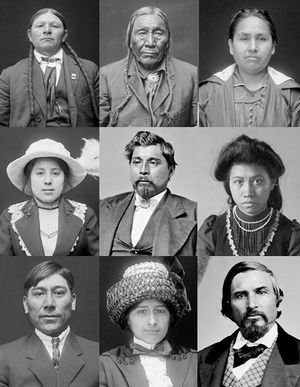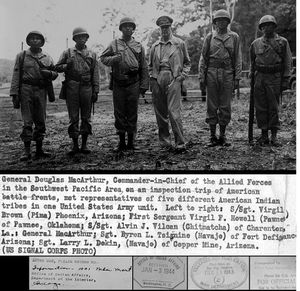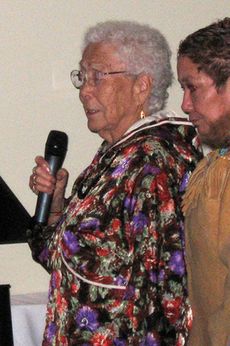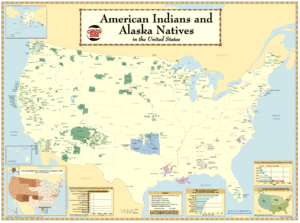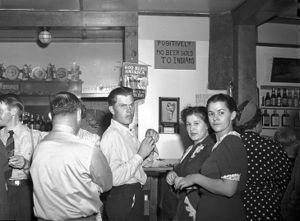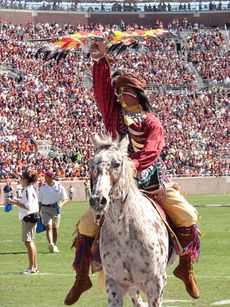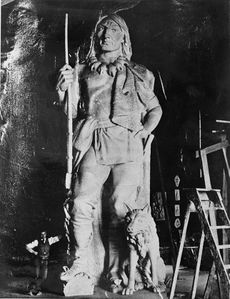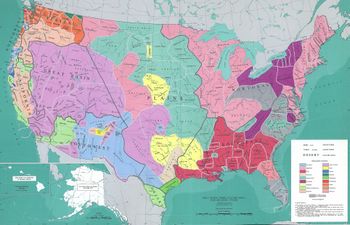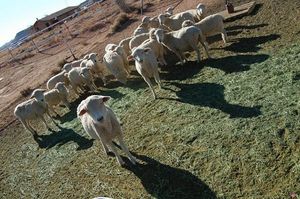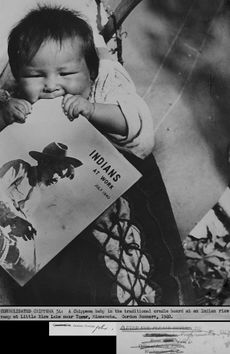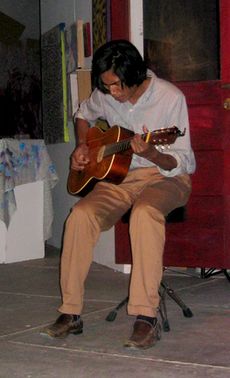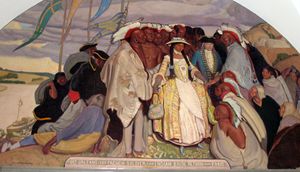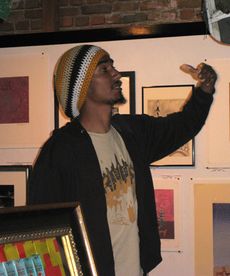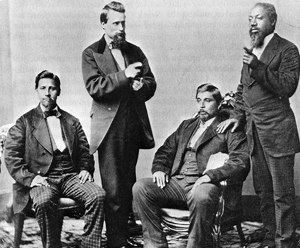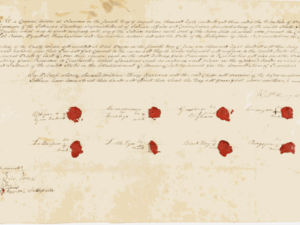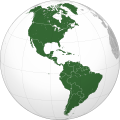الأمريكان الأصليون في الولايات المتحدة
            الأمريكان الأصليون في الولايات المتحدة (من أعلى اليسار): جوزيف برانت • Sequoyah • Pushmataha Tecumseh • Touch the Clouds • سيتينگ بول تشيف جوستف • تشارلز إستمان • Billy Bowlegs III جيم ثروپ • ويلما مانكيلر • جون هرينگتون | |
| إجمالي التعداد | |
|---|---|
| الأمريكان الهنود والشعوب الأصلية في آلاسكا عرق واحد: 2.5 مليون مسجلون[1] عرق أو أكثر: 1.6 مليون مسجلون[2] 1.37% من سكان الولايات المتحدة | |
| المناطق ذات التجمعات المعتبرة | |
| في الغالب في غرب الولايات المتحدة | |
| اللغات | |
| أمريكية إنگليزية، لغات الأمريكان الأصليين | |
| الدين | |
| الكنيسة الأمريكية الأصلية پروتستانت رومانية كاثوليكية ارثوذكسية روسية عقائد خاصة (حسب كل قبيلة) | |
| الجماعات العرقية ذات الصلة | |
| الشعوب الأصلية للأمريكتين |
الأمريكان الأصليون في الولايات المتحدة Native Americans in the United States، هم الشعوب الأصلية في أمريكا الشمالية على الحدود المعاصرة للولايات المتحدة القارية، أجزاء من ألاسكا، وولاية هاواي. ويتكون الأمريكان الأصليون من عدد، متمايز من القبائل الأمريكية الأصلية والجماعات العرقية، مجموعات كبيرة من التجمعات السياسية. يستخدم المصطلح للاشارة إلى الأمريكان الأصليين الذين كانو محل جدل. حسب مقابلات رئيسية أجراها مكتب الاحصاء الأمريكي عام 1995، فإن معظم من شملهم الاستطلاع يفضلون تسمية أنفسهم بالأمريكان الهنود أو الهنود، وقد اعتمد هذا المصطلح من قبل الصحف الكبر وبعض المجموعات الأكاديمية، ولا يشمل المصطلح الهاوائيون الأصليون أو الأصليون الألاسكيون، مثل شعوب الألويت، الألوتيك، الكوپيك، اليوپيك، والإنويت، الذين لا يعتبرو من الأمريكان الهنود.
منذ نهاية القرن الخامس عشر، أدت هجرة الاوروپيين إلى الأمريكتين، وإحضارهم الأفارقة معهم كعبيد، إلى قرون من النزاع والتسوية بين مجتمعات العالم القديم والجديد. أسس الاوروپيون معظم السجلات التاريخية المبكرة المكتوبة عن الأمريكان الأصليين بعد هجرة المستعمرين إلى الأمريكتين.[3] عاش معظم الأمريكان الأصليين كمجتمعات بدائية ونقلو تراثهم التاريخي شفهياً. في الكثير من المجموعات، قامت النساء بمهام زراعية متطورة لأنواع مختلفة من المحاصيل الزراعية، مثل الذرة، الفول، والكوسة. كانت ثقافة الشعوب الأصلية تختلف تماما عن الشعوب الزراعية، والصناعية المتطورة، معظم المهاجرون المسيحيون كانوا من غرب اوراسيا. معظم الثقافات الأصلية كانت Matrilineality؛ احتل الشعب الأراضي للاستخدام المحلي، لأغراض الصيد أو الزراعة. كان للاوروپيين في ذلك الوقت ثقافات أبوية وقاموا بتطوير حقوق الملكية الفردية مع احترام الأراضي التي كان مختلف عليها.
اختلاف الثقافات بين الأمريكان الأصليين والاوروپيون المهاجرون، بالإضافة إلى تغير التحالفات بين الشعوب المختلفة عبر القرون، أدى إلى حالة من التوتر السياسي، العنف العرقي والخلل الاجتماعي. عانى الأمريكان الأصليون من ارتفاع نسبة الوفيات نتيجة الاصابة بالأمراض الاوراسية المعدية، والتي لم يكن لديهم مناعة ضدها. أدت الأوبئة التي انتشرت بعد الاختلاط مع الاوروپيين إلى انخفاض متوسط الحياة ونقص عدد سكان الشعوب الأصلية. يوجد تباين كبير في تقديرات عدد سكان الولايات المتحدة في فترة ما قبل كولومبس، حيث تتراوح بين مليون إلى 18 مليون نسمة.[4][5]
بعد ثورة المستعمرات على بريطانيا العظمى وتأسيس الولايات المتحدة الأمريكية، وضع الرئيس جورج واشنطن وهنري نوكس تصور لحضارة الأمريكان الأصليين استعداداً لاستيعابهم كمواطنين أمريكيين.[6][7][8][9][10] Assimilation (whether voluntary as with the Choctaw,[11][12] أو مجبرين) وأصبحت سياسة ثابتة تبنتها الادارة الأمريكية.
التاريخ
قبل كلومبس
وفقًا لملاحم الأيسلنديين، استوطن البحارة الشماليون (غالبًا ما يطلق عليهم اسم الفايكنغ) من آيسلندا في غرينلاند في ثمانينيات القرن العاشر. اكتشف إريك الأحمر جنوب غرب غرينلاند واستقر فيها، وأسماها غرينلاند (الأرض الخضراء) لجذب أكبر عدد ممكن من المستوطنين الآيسلنديين، وفي النهاية أنشأ المستعمرات الشرقية والغربية التي هُجرت عام 1351 تقريبًا.
يعد موقعا لانس أو ميدوز (خليج قناديل البحر)، الأثري في أقصى شمال نيوفاوندلاند، وموقع ثان جنوب غرب نيوفاوندلاند، المواقع الوحيدة المعروفة لقرى الشماليين في أمريكا الشمالية خارج غرينلاند. تتميز هذه المواقع بصلات محتملة مع مستعمرة فينلاند التي حاول ليف إريكسون تأسيسها عام 1003.
لم تكن رحلات الفايكنغ معروفة في العالم القديم، وظل الأوروبيون غير مدركين لوجود الأمريكيتين ككل.
أيضا توجد دراسات حول معرفة المسلمين من الأندلس وغرب إفريقيا لشعوب الأمريكان الأصليين.
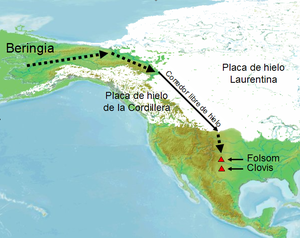
الاستكشاف الاوروپي والاستعمار


أسس الحرية
الثورة الأمريكية
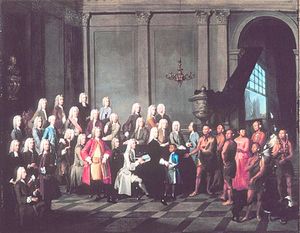
الولايات المتحدة في القرن 18
القرن 19
النهضة
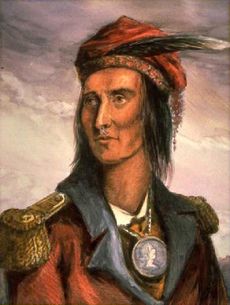
التوسع الأمريكي

الحرب الأهلية
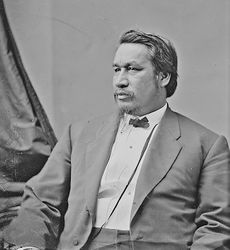
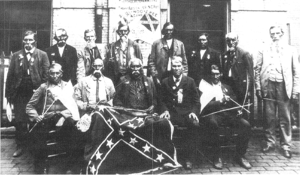
الزوال والحفاظ
الأمريكان الأصليون والمواطنة الأمريكية
القرن 20

الحرب العالمية الثانية
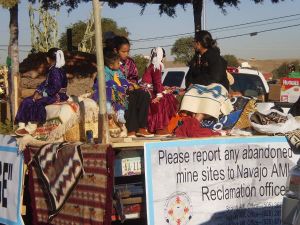
قضايا معاصرة
"It has long been recognized that Native Americans are dying of diabetes, alcoholism, tuberculosis, suicide, and other health conditions at shocking rates. Beyond disturbingly high mortality rates, Native Americans also suffer a significantly lower health status and disproportionate rates of disease compared with all other Americans."
— The U.S. Commission on Civil Rights, September 2004[17]
التمييز المجتمعي والعنصرية
| جزء من سلسلة مقالات عن |
| حقوق السكان الأصليين |
|---|
| حقوق |
| منظمات حكومية |
| المنظمات الأهلية والجماعات السياسية |
| قضايا |
| التمثيل القانوني |
| تصنيفات متعلقة |
شعارات الأمريكان الأصليين في الرياضة
التصوير التاريخي في الفن
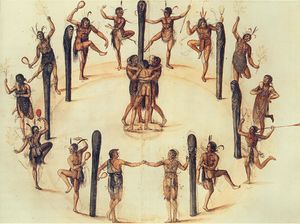
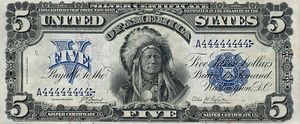
صناعة القمار
المجتمع، اللغة، والثقافة
التصنيف العرقي-اللساني
يمكن تصنيف الشعوب الأصلية في أمريكا الشمالية إلى عدد من المناطق الثقافية الكبيرة:
- أصليوا آلاسكا
- القطب الشمالي: إسكيمو–أليوت
- مناطق شبه قطبية: Northern Athabaskan
- Western United States
- قبائل كاليفورنيا (الشمالية): Yok-Utian, Pacific Coast Athabaskan, Coast Miwok, يوروك, Palaihnihan, Chumashan, Uto-Aztecan
- Plateau tribes: Interior Salish, Plateau Penutian
- Great Basin tribes: Uto-Aztecan
- ساحل شمال غرب الهادي: Pacific Coast Athabaskan, Coast Salish
- القبائل الجنوبية الغربية: Uto-Aztecan, Yuman, Southern Athabaskan
- Central United States
- Eastern United States
المفاهيم الثقافية
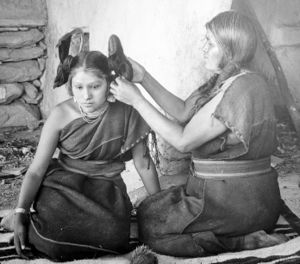
التنظيم

الزراعة
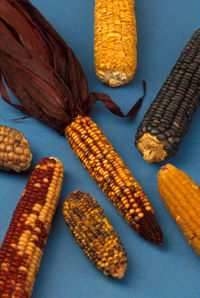
الديانة
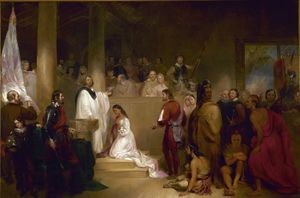
الموسيقى والفن
الاقتصاد
حواجز تعرقل التنمية الاقتصادية
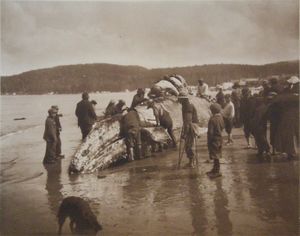
الانصهار
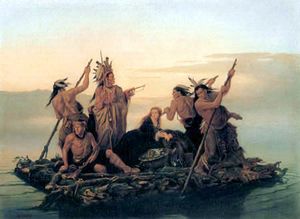
العبودية
الأمريكان الأصليين والعلاقات الأفريقية
من هم الأمريكان الأصليون؟
الاختلاط وعلم الوراثة
التعداد
- ألاسكا – 13.1% 101,352
- نيو مكسيكو – 9.7% 165,944
- داكوتا الشمالية – 8.6% 60,358
- اوكلاهوما – 6.8% 262,581
- مونتانا – 6.3% 57,225
- داكوت الجنوبية – 5.2% 30,552
- أريزونا – 4.5% 261,168
- وايومنگ – 2.2% 10,867
- اوريگون – 1.8% 45,633
- واشنطن – 1.5% 104,819
- نڤادا – 1.2%
- أيداهو – 1.1%
- كارولاينا الشمالية – 1.1%
- يوتا – 1.1%
- مينيسوتا – 1.0%
- كولورادو – 0.9%
- كنساس – 0.9%
- نبراسكا – 0.9%
- ويسكنسن – 0.9%
- أركنساس – 0.8%
- كاليفورنيا – 0.7%
- لويزيانا – 0.6%
- مين – 0.5%
- ميشگن – 0.5%
- تكساس – 0.5%
- ألاباما – 0.4%
- مسيسپي – 0.4%
- ميزوري – 0.4%
- رود آيلاند – 0.4%
- ڤرمونت – 0.4%
- فلوريدا – 0.3%
- ديلاوير – 0.3%
- هاواي – 0.3%
- إيوا – 0.3%
- نيويورك – 0.3%
- كارولينا الجنوبية – 0.3%
- تنسي – 0.3%
- جورجيا – 0.2%
- ڤيرجينيا – 0.2%
- كنتيكت – 0.2%
- إلينوي – 0.2%
- إنديانا – 0.2%
- كنتكي – 0.2%
- ماريلاند – 0.2%
- مساتشوستس – 0.2%
- نيو هامپشر – 0.2%
- نيو جيرزي – 0.2%
- أوهايو – 0.2%
- ڤرجنيا الغربية – 0.2%
- پنسلڤانيا – 0.1%
- مقاطعة كولومبيا – 0.3%
- پورتو ريكو – 0.2%
- هاواي – 8.7
- يتوتا – 0.7
- ألاسكا – 0.6
- كاليفورنيا – 0.4
- نيڤادا – 0.4
- واشنطن – 0.4
- أريزونا – 0.2
- اوريگون – 0.2
- ألاباما – 0.1
- أركنساس – 0.1
- كولورادو – 0.1
- فلوريدا – 0.1
- إيداهو – 0.1
- كنتكي – 0.1
- ماريلاند – 0.1
- مساتشوستس – 0.1
- ميزوري – 0.1
- مونتانا – 0.1
- نيو مكسيكو – 0.1
- كارولينا الشمالية – 0.1
- اوكلاهوما – 0.1
- كارولينا الجنوبية – 0.1
- تكساس – 0.1
- ڤيرجينيا – 0.1
- ڤيرجينيا الغربية – 0.1
- وايومنگ – 0.1
توزيع السكان
توزيع السكان عام 2000.[19]
| Tribal grouping | American and Alaska Native alone | American and Alaska Native alone | American Indian and Alaska Native in combination with one or more races | American Indian and Alaska Native in combination with one or more races | American Indian and Alaska Native tribal grouping alone or in any combination |
| Tribal grouping | One tribal grouping reported | More than one tribal grouping reported | One tribal grouping reported | More than one tribal grouping reported | |
| الاجمالي | 2,423,531 | 52,425 | 1,585,396 | 57,949 | 4,119,301 |
| Apache | 57,060 | 7,917 | 24,947 | 6,909 | 96,833 |
| Blackfeet | 27,104 | 4,358 | 41,389 | 12,899 | 85,750 |
| Cherokee | 281,069 | 18,793 | 390,902 | 38,769 | 729,533 |
| Cheyenne | 11,191 | 1,365 | 4,655 | 993 | 18,204 |
| Chickasaw | 20,887 | 3,014 | 12,025 | 2,425 | 38,351 |
| Chippewa | 105,907 | 2,730 | 38,635 | 2,397 | 149,669 |
| Choctaw | 87,349 | 9,552 | 50,123 | 11,750 | 158,774 |
| Colville | 7,833 | 193 | 1,308 | 59 | 9,393 |
| Comanche | 10,120 | 1,568 | 6,120 | 1,568 | 19,376 |
| Cree | 2,488 | 724 | 3,577 | 945 | 7,734 |
| Creek | 40,223 | 5,495 | 21,652 | 3,940 | 71,310 |
| Crow | 9,117 | 574 | 2,812 | 891 | 13,394 |
| Delaware | 8,304 | 602 | 6,866 | 569 | 16,341 |
| Houma | 6,798 | 79 | 1,794 | 42 | 8,713 |
| Iroquois | 45,212 | 2,318 | 29,763 | 3,529 | 80,822 |
| Kiowa | 8,559 | 1,130 | 2,119 | 434 | 12,242 |
| Latin American Indian | 104,354 | 1,850 | 73,042 | 1,694 | 180,940 |
| Lumbee | 51,913 | 642 | 4,934 | 379 | 57,868 |
| Menominee | 7,883 | 258 | 1,551 | 148 | 9,840 |
| Navajo | 269,202 | 6,789 | 19,491 | 2,715 | 298,197 |
| Osage | 7,658 | 1,354 | 5,491 | 1,394 | 15,897 |
| Ottawa | 6,432 | 623 | 3,174 | 448 | 10,677 |
| Paiute | 9,705 | 1,163 | 2,315 | 349 | 13,532 |
| Pima | 8,519 | 999 | 1,741 | 234 | 11,493 |
| Potawatomi | 15,817 | 592 | 8,602 | 584 | 25,595 |
| Pueblo | 59,533 | 3,527 | 9,943 | 1,082 | 74,085 |
| Puget Sound Salish | 11,034 | 226 | 3,212 | 159 | 14,631 |
| Seminole | 12,431 | 2,982 | 9,505 | 2,513 | 27,431 |
| Shoshone | 7,739 | 714 | 3,039 | 534 | 12,026 |
| Sioux | 108,272 | 4,794 | 35,179 | 5,115 | 153,360 |
| Tohono O’odham | 17,466 | 714 | 1,748 | 159 | 20,087 |
| Ute | 7,309 | 715 | 1,944 | 417 | 10,385 |
| Yakama | 8,481 | 561 | 1,619 | 190 | 10,851 |
| Yaqui | 15,224 | 1,245 | 5,184 | 759 | 22,412 |
| Yuman | 7,295 | 526 | 1,051 | 104 | 8,976 |
| Other specified American Indian tribes | 240,521 | 9,468 | 100,346 | 7,323 | 357,658 |
| American Indian tribe, not specified2 | 109,644 | 57 | 86,173 | 28 | 195,902 |
| Alaska Athabascan | 14,520 | 815 | 3,218 | 285 | 18,838 |
| Aleut | 11,941 | 832 | 3,850 | 355 | 16,978 |
| Eskimo | 45,919 | 1,418 | 6,919 | 505 | 54,761 |
| Tlingit-Haida | 14,825 | 1,059 | 6,047 | 434 | 22,365 |
| Other specified Alaska Native tribes | 2,552 | 435 | 841 | 145 | 3,973 |
| Alaska Native tribe, not specified | 6,161 | 370 | 2,053 | 118 | 8,702 |
| American Indian or Alaska Native tribes, not specified3 | 511,960 | (X) | 544,497 | (X) | 1,056,457 |
علم الجينات
الذكرى
قام الأرشيف الوطني بفحص لأكثر من 300 اتفاقية بين الولايات المتحدة وقبائل السكان الأصليين.تضم المجموعة عبر الإنترنت 374 معاهدة هندية مصدق عليها من مقتنيات الأرشيف. وفقًا لمدونة ، توجد هذه الوثائق في منطقة محمية بشكل خاص في مبنى الأرشيف الوطني وهي غير متاحة للاستخدام في غرفة الأبحاث المركزية بسبب هشاشتها وأهميتها. أكثر من 50 معاهدة مكتوبة على أوراق كبيرة من الرق ؛ يحتوي العديد منها على رسومات وخرائط ومبوم أو خرز زخرفي يستخدم كعملة في بعض قبائل الأمريكيين الأصليين.
قال ديلا واريور ، مدير MIAC وعضو في قبيلة أوتو ميسوريا ، لصحيفة البوكيرك جورنال: "المعاهدات بين الولايات المتحدة والدول الأصلية وثيقة الصلة بالموضوع ، وقليل من الناس لديهم إمكانية الوصول إلى معرفة المعاهدات المتعلقة بالمكان الذي يعيشون فيه". أدريان جوميز. "يسر MIAC أن تكون قادرًا على توفير هذا المورد عبر الإنترنت الذي يمكننا جميعًا استخدامه لاستكشاف علاقاتنا باستخدام الخرائط ومجموعة منسقة بعناية من الوثائق التاريخية من الأرشيفات الوطنية ومكتبة الكونگرس و Smithsonian ومصادر أخرى."[20]
انظر أيضاً
- الشعوب الأصلية في كندا
- ألاسكيون أصليون
- American Indian College Fund
- American Indian elder
- Native Americans in children's literature
- Native Americans in popular culture
- Portrayal of Native Americans in Film
- List of company and product names derived from indigenous peoples
- Indian Campaign Medal
- Indian Claims Commission
- مذبحة الهنود الحمر
- Indian old field
- Indian Reorganization Act
- Indian Territory
- Inter-Tribal Environmental Council (ITEC)
- List of English words from indigenous languages of the Americas
- List of Indian reservations in the United States
- List of Native Americans of the United States
- List of pre-Columbian civilizations
- List of sports team names and mascots derived from indigenous peoples
- List of unrecognized tribes in the United States
- State recognized tribes in the United States
- قائمة الكتاب من الأمريكان الأصليين
- الاحصائيات الاجتماعية الحديثة للأمريكان الأصليين
- الحقوق المدنية للأمريكان الأصليين
- Native American mythology
- Native American pottery
- Native American tribes in Nebraska
- Outline of United States federal indian law and policy
- Population history of American indigenous peoples
- Title 25 of the Code of Federal Regulations
- Title 25 of the United States Code
- Treaties of the United States (includes Native American treaties)
هوامش
- ^ U.S. Census Bureau. (2001–2005). Profiles of General Demographic Characteristics 2000: 2000 Census of Population and Housing. U.S. Census Bureau. Retrieved on 2007-05-23.
- ^ U.S. Census Bureau. (2001–2005). Profiles of General Demographic Characteristics 2000: 2000 Census of Population and Housing. U.S. Census Bureau. Retrieved on 2007-05-23. "In combination with one or more of the other races listed." Figure here derived by subtracting figure for "One race (American Indian and Alaska Native)": 2,475,956, from figure for "Race alone or in combination with one or more other races (American Indian and Alaska Native)": 4,119,301, giving the result 1,643,345. Other races counted in the census include: "White"; "Black or African American"; "Asian"; "Native Hawaiian and Other Pacific Islander"; and "Some other race."
- ^ Calloway, Colin G. "Native Americans First View Whites from the Shore." American Heritage, Spring 2009. Retrieved 29 Dec 2011
- ^ Bruce E. Johansen (2006-11). The Native Peoples of North America. Rutgers University Press. ISBN 978-0-8135-3899-0. Retrieved June 28, 2009.
{{cite book}}: Check date values in:|date=(help) - ^ "Native American". Encyclopædia Britannica. Retrieved June 28, 2009.
- ^ Perdue, Theda (2003). "Chapter 2 "Both White and Red"". Mixed Blood Indians: Racial Construction in the Early South. The University of Georgia Press. p. 51. ISBN 0-8203-2731-X.
- ^
Remini, Robert (1977, 1998). ""The Reform Begins"". Andrew Jackson. History Book Club. p. 201. ISBN 0-06-080132-8.
{{cite book}}: Check date values in:|year=(help) - ^
Remini, Robert (1977, 1998). ""Brothers, Listen ... You Must Submit"". Andrew Jackson. History Book Club. p. 258. ISBN 0-06-080132-8.
{{cite book}}: Check date values in:|year=(help) - ^
Miller, Eric (1994). "George Washington and Indians". Eric Miller. Retrieved 2008-05-02.
{{cite web}}:|chapter=ignored (help); More than one of|author=and|last=specified (help) - ^
Jewett, Tom (1996–2009). "Thomas Jefferson's Views Concerning Native Americans". Archiving America. Retrieved 2009-02-17.
{{cite web}}: More than one of|author=and|last=specified (help) - ^ "An Indian Candidate for Congress". Christian Mirror and N.H. Observer, Shirley, Hyde & Co. July 15, 1830.
- ^
Kappler, Charles (1904). "Indian affairs: laws and treaties Vol. II, Treaties". Government Printing Office. Retrieved 2008-04-16.
{{cite web}}: More than one of|author=and|last=specified (help) - ^ "American Indian and Alaska Native Heritage Month: November 2011". U.S. Census Bureau.
- ^ Eric Miller (1994). "Washington and the Northwest War, Part One". Retrieved 2010-08-11.
- ^ "Past Notable Native Americans". Snowwowl.com. Retrieved 2010-08-22.
- ^ Ely Parker Famous Native Americans.
- ^ Broken Promises: Evaluating the Native American Health Care System by the U.S. Commission on Civil Rights, September 2004.
- ^ Charles Hudson, The Southeastern Indians, 1976, p. 479.
- ^ "2000 Summary File 1 – US Census Bureau" (PDF). US Census Bureau. 2007}accessdate=2010-11-01.
{{cite web}}: Check date values in:|year=(help) - ^ "Hundreds of Native American Treaties Digitized for the First Time".
المصادر
- Barak, Gregg, Paul Leighton, and Jeanne Flavin. Class, Race, Gender, and Crime: The Social Realities of Justice in America. Lanham, MD: Rowman and Littlefield, 2010. ISBN 978-0-7425-9969-7.
قراءات إضافية
- Adams, David Wallace. Education for Extinction: American Indians and the Boarding School Experience 1875–1928, University Press of Kansas, 1975. ISBN 0-7006-0735-8 (hbk); ISBN 0-7006-0838-9 (pbk).
- Bierhorst, John. A Cry from the Earth: Music of North American Indians. ISBN 0-941270-53-X.
- Deloria, Vine. 1969. Custer Died for Your Sins: An Indian Manifesto. New York: Macmillan.
- Electronic Code of Federal Regulations (e-CFR), Title 50: Wildlife and Fisheries Part 22-Eagle permits "Electronic Code of Federal Regulations:". Ecfr.gpoaccess.gov. 2007-02-27. Retrieved 2010-08-22.
- Hirschfelder, Arlene B.; Byler, Mary G.; & Dorris, Michael. Guide to research on North American Indians. American Library Association (1983). ISBN 0-8389-0353-3.
- Johnston, Eric F. The Life of the Native American, Atlanta, GA: Tradewinds Press (2003).
- Johnston, Eric. The Life Of the Native. Philadelphia, PA: E.C. Biddle, etc. 1836–44. University of Georgia Library.
- Jones, Peter N. Respect for the Ancestors: American Indian Cultural Affiliation in the American West. Boulder, CO: Bauu Press (2005). ISBN 0-9721349-2-1.
- Kroeber, Alfred L. (1939). Cultural and Natural Areas of Native North America. University of California Publications in American Archaeology and Ethnology.
- Nichols, Roger L. Indians in the United States & Canada, A Comparative History. University of Nebraska Press (1998). ISBN 0-8032-8377-6.
- Pohl, Frances K. (2002). Framing America: A Social History of American Art. New York: Thames & Hudson. pp. 54–56, 105–106 & 110–111. ISBN 0-500-23792-1.[dead link]
- Shanley, Kathryn Winona (2004). "The Paradox of Native American Indian Intellectualism and Literature". Melus. 29.
- Shanley, Kathryn Winona (1997). "The Indians America Loves to Love and Read: American Indian Identity and Cultural Appropriation". American Indian Quarterly. 21 (4): 675–702. doi:10.2307/1185719.
- Krech, Shepard. The Ecological Indian: Myth and History, New York: W.W. Norton, 1999. 352 p. ISBN 0-393-04755-5
- Shohat, Ella; Stam, Robert (1994). Unthinking Eurocentrism: Multiculturalism and the Media. New York: Routledge. ISBN 0-415-06324-8.
- Sletcher, Michael, "North American Indians", in Will Kaufman and Heidi Macpherson, eds., Britain and the Americas: Culture, Politics, and History, New York: Oxford University Press, 2005, 2 vols.
- Snipp, C.M. (1989). American Indians: The first of this land. New York: Russell Sage Foundation. ISBN 0-87154-822-4.
- Sturtevant, William C. (Ed.). Handbook of North American Indians (Vol. 1–20). Washington, D. C.: Smithsonian Institution. (Vols. 1–3, 16, 18–20 not yet published), (1978–present).
- Tiller, Veronica E. (Ed.). Discover Indian Reservations USA: A Visitors' Welcome Guide. Foreword by Ben Nighthorse Campbell. Denver, CO: Council Publications, 1992. ISBN 0-9632580-0-1.
وصلات خارجية
- "First Nations Experience Television", 2011, Official Website, multi-media platform, a partnership between the San Manuel Band of Mission Indians and KVCR, a PBS member station located in California’s Inland Empire.
- Native American Treaties and Information from UCB Libraries GovPubs
- Native American History from the Library of Congress American Memory project
- الأمريكان الأصليون في الولايات المتحدة at the Open Directory Project
- Native American Historical Records, Archival Research Catalog, National Archives and Records Administration
- Bonneville Collection of 19th century photographs of Native Americans, University of South Carolina Library's Digital Collections Page
- "Researching Individual Native Americans", National Archives at Atlanta
- National Congress of American Indians
- National Museum of the American Indian
- US Department of the Interior: Indian Affairs
- CS1 errors: redundant parameter
- CS1 errors: chapter ignored
- CS1: Julian–Gregorian uncertainty
- "Related ethnic groups" needing confirmation
- Articles using infobox ethnic group with image parameters
- Articles with hatnote templates targeting a nonexistent page
- Articles with dead external links from August 2011
- موضوعات عن الأمريكان الأصليين
- ثقافة الأمريكان الأصليين
- تاريخ الأمريكان الأصليين
- شعوب أصلية في الولايات المتحدة
- جماعات عرقية في الولايات المتحدة
- العلاقات الأفريقية والأمريكان الأصليون
- ثقافة أمريكية
- تاريخ الحقوق المدنية في الولايات المتحدة
- تاريخ المستعمرات الثلاثة عشر
- تاريخ أمريكا الشمالية
- التاريخ الاجتماعي في الولايات المتحدة


